A history of the Decaturian, Millikin's student newspaper and the voice of the students

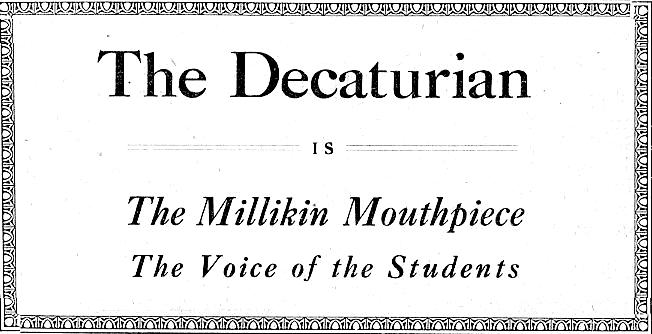
This web exhibit is based upon an Archives exhibit which was on display inside Staley Library at Millikin University during the Fall semester of 2008.
Dawn of the Decaturian, maker of the mouthpiece
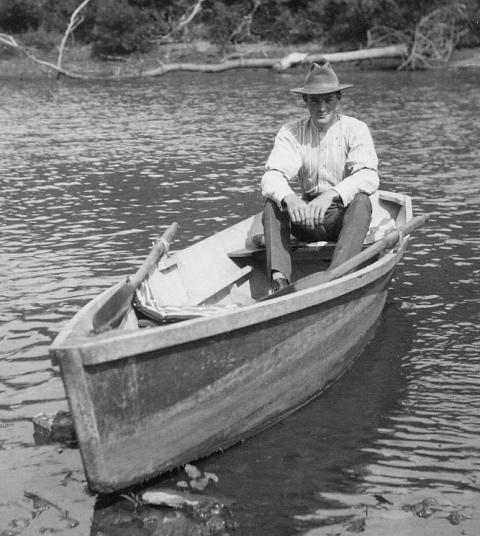
I. Laurence "Bill" Sears ~ First Editor/Manager of The Decaturian
The Decatur College & Industrial School of the James Millikin University (what is today Millikin University) opened its doors to students in September 1903. The James Millikin University had come into existence in 1901 by amending the 1865 Lincoln College charter and that school then became a part of the James Millikin University along with the new college in Decatur (that union of the two schools was legally dissolved in July of 1953, and since that time JMU has been simply known as Millikin University or MU). The first graduating class of the JMU was actually the June 1903 class graduating from Lincoln College and among their number was I. Laurence "Bill" Sears.

Bill Sears' 1903 Lincoln College Pin
At the request of university president, Albert Reynolds Taylor, Sears came to Decatur in the fall of 1903 to take classes in cabinetry at the new college while also launching its student newspaper, The Decaturian. In the fall of 1915, as the university was about to celebrate its first ever homecoming, Sears sent a letter to Professor Bonnie Blackburn [for whom Blackburn Hall, location of today's Decaturian office, would later be named. She had also worked on the Dec staff while she was a student, see the June 1907 Masthead in the "Girls Did This" section below], responding to questions about the creation of The Decaturian.
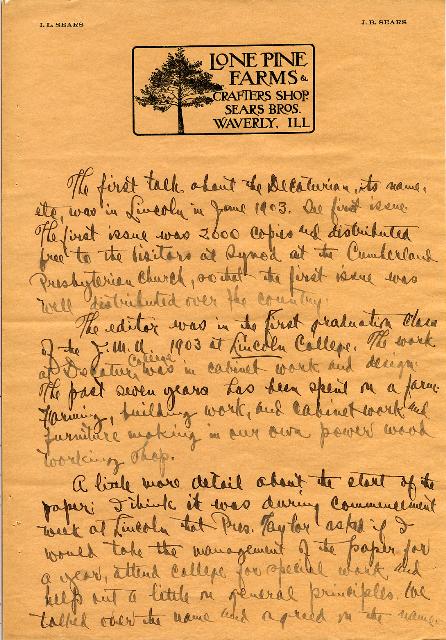
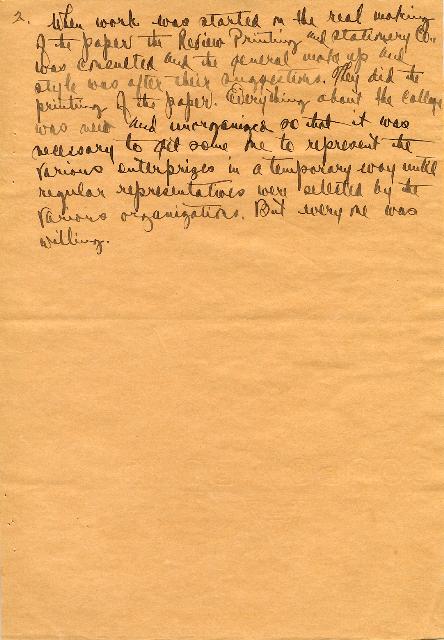
Sears' original two page letter to Bonnie Blackburn from the November 15, 1915.
In the letter, excerpted below, Sears immediately referred Blackburn to the first issue of The Decaturian, which contained an editorial explaining its foundation.
You can read that editorial on page 5 of that original October 1903 issue by clicking on the button below.
”The first talk about the Decaturian, its name, etc. was in Lincoln in June 1903. See first issue. The first issue was 2000 copies and distributed free to the visitors at Synod at the Cumberland Presbyterian Church, so that the first issue was well distributed over the country…
“…I think it was during commencement week at Lincoln that Pres. Taylor asked if I would take the management of the paper for a year, attend college for special work, and help out a little on general principles. We talked over the name and agreed on the name.
"When work was started on the real making of the paper, the Review Printing and Stationary Co. was consulted and the general make up and style was after their suggestions. They did the printing of the paper. Everything about the college was new and unorganized so that it was necessary to get some one to represent the various enterprises in a temporary way until regular representatives were selected by the various organizations. But everyone was willing.”
[The Cumberland Presbyterian Church was an instrumental part of initial fund raising efforts that brought the James Millikin University into existence.]
That initial issue of 2000 copies referred to by Sears was issued on Tuesday, October 6th, 1903 and with it The Decaturian, or as it is more often referred to as, the Dec, was born, and is still going over century later.
Sears continued to serve as Editor and Business Manager of The Decaturian through that first academic year of 1903-04, publishing 8 monthly issues of The Decaturian in that period. In addition to launching a newspaper that has lasted over a century, he also found time to learn a skill in carpentry that he would use throughout his life to make a living, and also met his future wife, Anna Magill, who was a freshman in 1903 and in 1907 graduated from Millikin as part of the first four-year class to attend Millikin. At the time of Bill Sears' death in 1959, a collection of photographs, letters, and memorabilia, much of it pertaining to those earliest days of the university, was donated to the University and now resides among the University Archives' collections. Sears was also an avid photographer, and many of the original images of that first year and of the original campus buildings were photographs that he took. One of the treasures of that collection is a press pass, issued to Sears and The Decaturian for the 1904 St. Louis' World's Fair, known as the Louisiana Purchase Exposition.
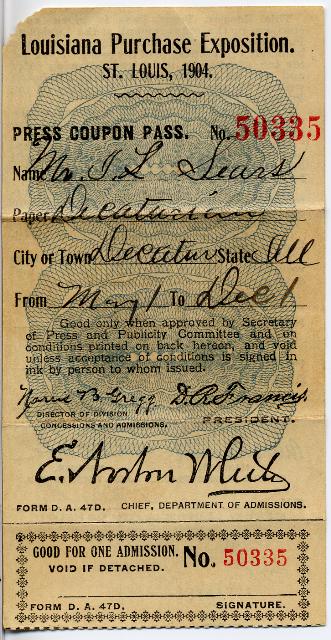
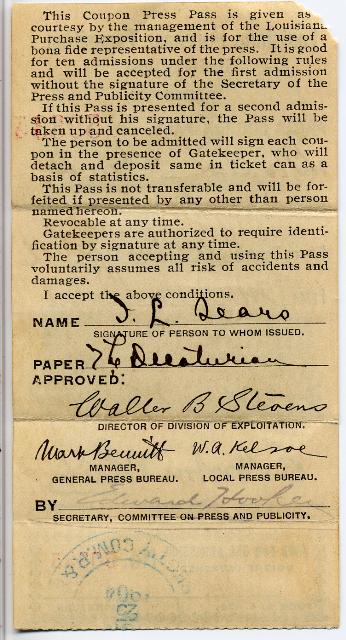
Front and Back of Bill Sears' Press Pass to the 1904 World's Fair in St. Louis
The second issue, November 1903, carried the first flag and masthead for The Decaturian, though these would change frequently over the years. The flag on top of the frontpage featured a silhoutte image of the campus buildings as it was in 1903, including the large smokestack that adjoined the original Machinery (later Mueller) Hall, and the masthead on the editorial page featured a bust of Stephen Decatur, for whom the city of Decatur, and in turn the newspaper, was named.
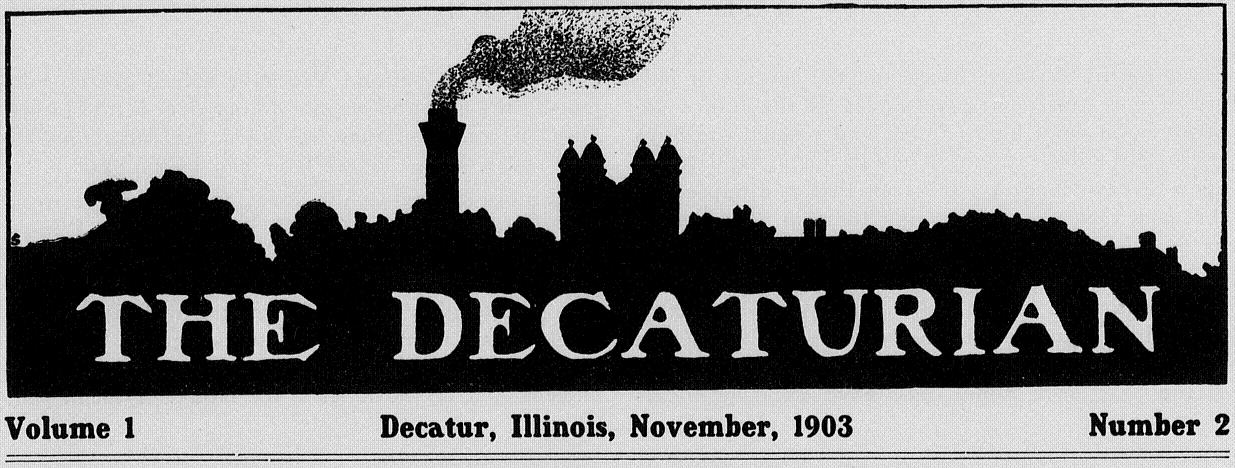
Original Flag across the top of the frontpage of the 2nd issue of the Decaturian
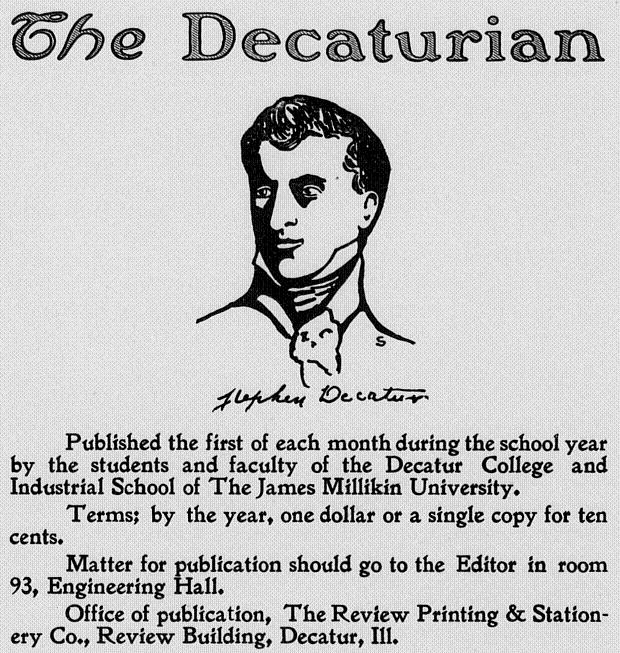
Original Masthead, from page 8 of 2nd issue
That same second issue also contained the text of the speech given by President Theodore Roosevelt, when he had come to Decatur in June of 1903 to dedicate the University.
You can read that speech, and view the entire November 1903 issue by clicking on the button below.
Monthly, weekly or occassionally?
The original Decaturians were monthly issues with paper covers, usually containing over twenty pages. They were more like small magazines than newspapers and it is in this magazine form that The Decaturian would exist during the first eight years of the University. All that would change in 1911. In the June 1911 issue (the final issue for 1910-1911 academic year) an editorial appeared in which it was suggested that a change to a weekly newspaper format from the tradition monthly magazine was being considered by the editor and business manager of The Decaturian for the upcoming academic year. You can read the entire editorial on page 16 of that issue by clicking on the button below.
Arthur Neidermeyer (Editor-in-chief) and Everett Pinkstaff (Business Manager) did in fact go through with their plans and when the first issue came out that fall of 1911, The Decaturian had a new format.

Decaturian Staff 1911-1912 year (From 1912 Millidek yearbook page 104) Editor-in-Chief Arthur Niedermeyer is seated on the left and Business Manager Everett Pinkstaff is seated on the right
The first "weekly" issue of The Decturian appeared on September 12, 1911 and contained a "Greeting" on the editorial page announcing that a new weekly news sheet format had been adopted. Read that editorial by clicking on the button below.
It was an eight page issue as opposed to the monthly magazine format (which had three to four times that many pages in a typical issue). This new weekly format also increased the size of the pages which had previously been 8"x10" to 10"x14" sheets. Instead of the typical ten monthly issues, thirty-four weekly numbers were created that year and thirty-one were produced the following year. But as the fall semester of 1913, and the tenth anniversary of the opening of the University arrived, The Decaturian returned to its original, monthly magazine format in which it would remain for the next eight years.
As this "word from the management" on the front page of the September 1913 issue explained [click on button directly above], weekly news sheets worked great at large universities, but Millikin would be better served by a monthly magazine. And so it was that The Decaturian had a second eight- year run as a monthly.
In the fall of 1921, another new editor, Lois Engleman, and new business manager, Orval Diehl, decided that the University would be better served by a weekly newspaper than a monthly magazine arguing that "to truly serve Millikin, The Decaturian must be used to back things Millikin." It needed to be a weekly to be a promotional vehicle for Millikin events and to give a timeliness to student editorial opinion. You can read their explanation in the editorial titled "A Millikin Weekly" in the September 15, 1921 by clicking on the button below.
And so it was that once again The Decaturian became a weekly, and increased its page size to 12"x18”.
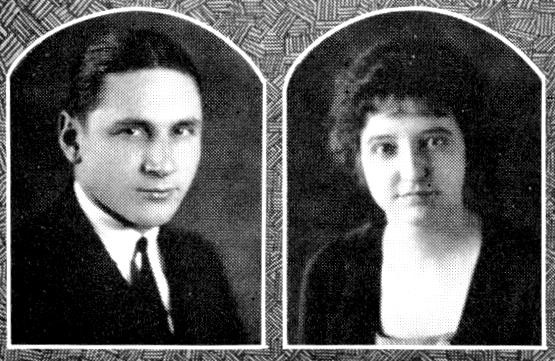
Orval Diehl and Lois Engleman of 1921-22 Decaturian
The Decaturian would continue as a weekly, except for a brief period towards the end of World War II until 1973. From 1973 until 1980 it became a bi-weekly and then in 1980 reverted back to a weekly until 1984 when it once again became a bi-weekly. In 1987, the page size was changed to 11"x17" as it has remained to this day, though it now is published roughly every three weeks in paper form, and since 1998, it has also found an entirely new format as a web based news source known as The Dec Online(link is external) with many of the articles from the paper being available online, in addition to uniquely web-based content such as blogs and the ability to comment directly to specific articles.
The girls did this
As you can see from the section directly above this, Lois Engleman served as Editor of The Decaturian in 1921. She was not the first woman to hold this position on the paper. In the spring of 1907, the male editor of the paper decided to leave school early to pursue a business opportunity and so for the first time in the history of The Decaturian, a woman's name would appear as Editor on the masthead.
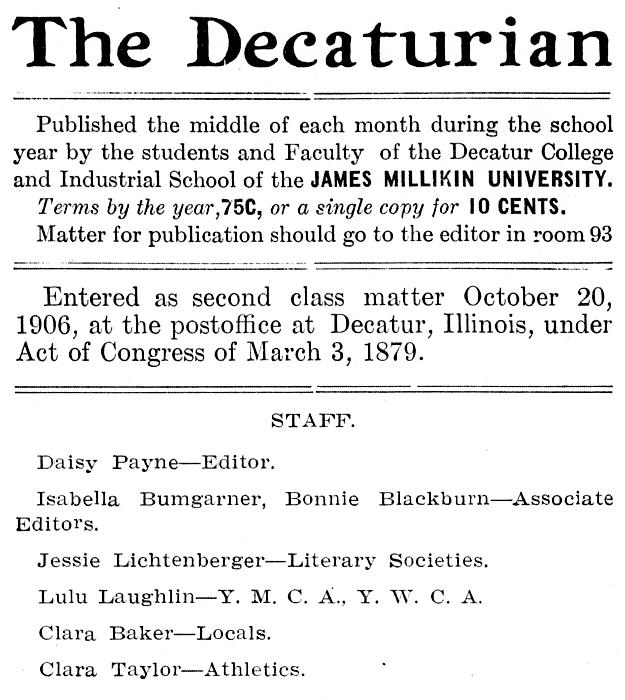
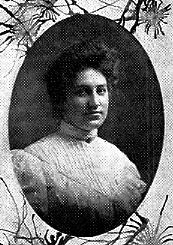
Masthead from June 1907 Decaturian (p8) & Daisy Payne (1907 Millidek)
In fact, this would be the only time until World War II where every staff position listed on the Masthead of a Decaturian issue would be held by a woman [including Assoc. editor Bonnie Blackburn, who would later join the faculty and receive the letter above from I.L. Sears]. The editorial explaining this fact went on to point out that "if anything in this paper displeases you say nothing about it, but smile sweetly and say to yourself, 'the girls did this, and it is their first experience.'" You can read the entire editorial on page 8 of the June 1907 issue by clicking on the button below.
However, this situation lasted only for one issue. It would be several more years before a woman was selected to be the Editor-in-chief for an entire academic year. Printer's ink apparently ran in Miss Payne's blood though (see the section below entitled "A Millikin Mouthpiece Marriage"). The Daisy Payne Young - Delta Delta Delta Scholarship at Millikin University is named in her honor.
In February 1916, the "regular staff" of the Decaturian temporarily stepped aside for a group of girls chosen from the Pi Mu Theta senior sorority to plan, write, edit, and proof that issue. While these women are not listed in the official Masthead, as in the June 1907 issue, this issue is the second "all-women" issue of the newspaper published before World War II. The poem on the front page of that issue (below) refers to this as the "first girls' issue of the Dec," which is incorrect.
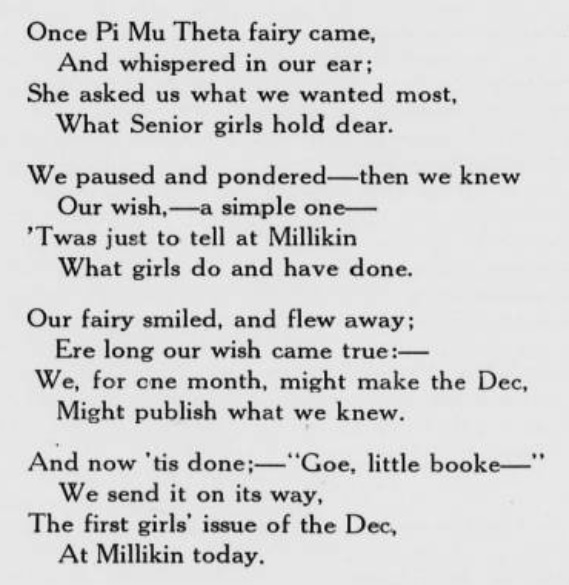
The first woman student to be selected as full-time editor of The Decaturian was Mary Parkinson in 1918.
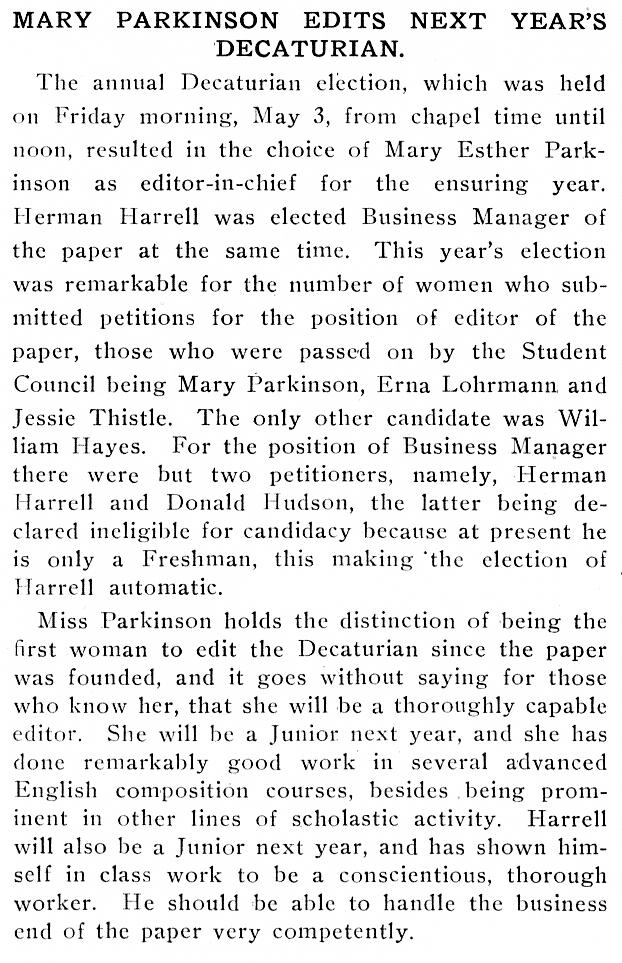
from THE DECATURIAN May 1918 page 9
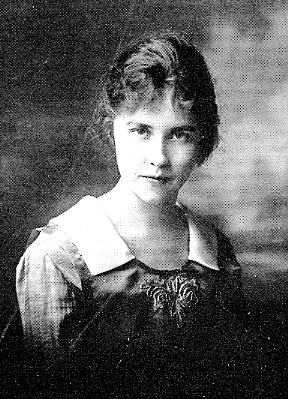
Mary Parkinson (1919 Millidek)
Part of the reason so many women students applied to be editor was that this was during the first World War and by the spring of 1918, the male population on campus had been depleted by so many male students enlisting in the military.
A Millikin mouthpiece marriage
The second Editor-in-chief of The Decaturian, taking over after I.L. Sears had gotten it all started that first year, was Dwight E. Young. He served in the position for the next two years (fall of 1904 to spring of 1906). He then left Millikin to take a job as a reporter with the Decatur Herald, becoming City Editor of that paper in 1907. He was a member of the class of 1907, though he did not graduate with them, and by 1909, he had become engaged to one if its more prominent female members, the aforementioned Daisy Payne. She had graduated in 1907 and was teaching in Decatur. The engagement of these two former Decaturian editors was appropriately announced to their unsuspecting friends at a tea party, by having a paper boy deliver 50 extra editions of the Decatur Herald that contained the engagement announcement. Of course, the September 1909 issue of The Decaturian carried a story about the engagement that you can read by clicking the button below.
The wedding was set for November and the November 1909 issue of The Decaturian carried a long story about the wedding, and several stories about returning alumni as so many had returned to Decatur for the nuptuals that it was almost like a homecoming weekend, click button below.
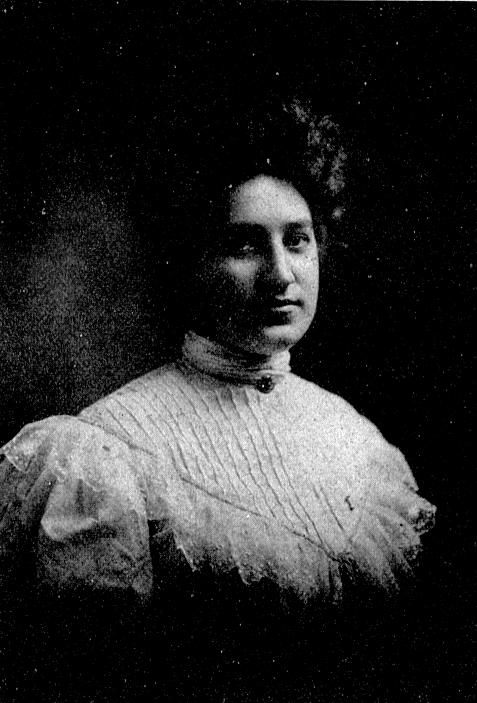
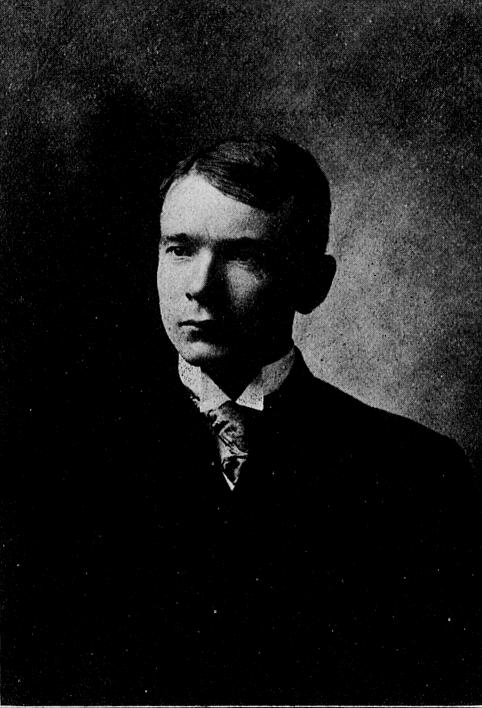
Daisy Payne Young (November 1911 Decaturian p.18) and Dwight E. Young (p.19)
In 1920, Dwight became Editor-in-chief of The Evening Herald and The Morning Journal of Dayton, Ohio. Daisy also wrote a column carried in both papers from 1920-1938. She died in Dayton in November of 1945. In 1949, the two papers were bought and merged into The Journal Herald of Dayton, and Dwight became both publisher and editor. He relinquished the editor part of his job in 1959 but continued to write a column and serve as publisher until his death in April of 1967.
DECATURIAN or TOKYO AMERICAN?

The Decaturian May 1905 page 6
In the spring of 1905, the above page appeared in the midst of the May issue of The Decaturian [click on button directly above] and was a follow up to a similar section that had appeared in the April 1905 issue [click on button directly below]
The Tokyo American was the creation of Masuji Matsumoto from Tokyo, Japan. He had been a part of the Japanese exhibit at the 1904 World's Fair in St. Louis [the same Fair that I. L. Sears had attended with the Press Pass pictured above], and then came to Millikin University as a Commerce and Finance student in January of 1905. He wrote several articles for The Decaturian, often informational articles about life in Japan. In the spring of 1908, he became the first International student to graduate from Millikin. He returned to Japan and went into the banking business there.
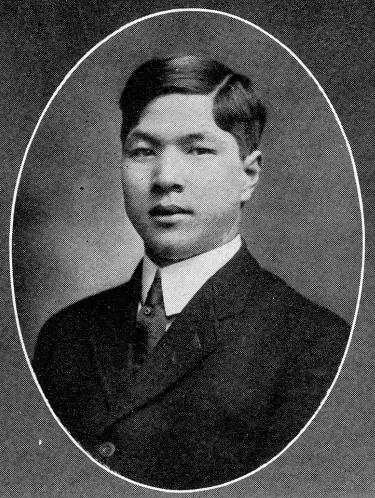
Masuji Matsumoto (1908 Millidek)
The bulk of the articles in the American refer to the activities of what was known as the J.M.U. Battalion. A male student military organization that had just come into existence at Millikin in January of 1905 [see related Dec article by clicking the button directly above] ) and had quickly become the most popular student organization on campus with military veterans among the faculty leading almost the entire male student body in military drills and exercises. Matsumoto's wrote accounts of these exercises, as if they were actual battles within the Russo-Japanese War that was then raging in East Asia, and in which Matsumoto's brother had been wounded in battle [you can read that account by clicking the button directly below]. The University Archives has a scrapbook with pictures taken during those spring of 1905 Battalion exercises among its collections.
DEPRESSED DECATURIAN DISAPPEARED
In the fall of 1931, Millikin University was feeling the impact of the Great Depression in several ways. Enrollment numbers had dropped drastically and with that the budget was slashed. The Decaturian, which had been dependent upon both subscriptions and advertisements for its survival to that point, was likewise feeling the depression as subscriptions from both students and alumni declined and fewer local advertisers were buying space. When the ninth issue of The Decaturian for that academic year was published on December 3, 1931 , there was no hint within it that there would not be a December 10th issue, but unfortunately, there would not be [click the button below to read the December 3, 1931 issue].
There would not be any issues the rest of that academic year, as The Decaturian had disappeared amidst the Depression. The paper was down, but it was not completely out. That spring, efforts were underway to bring the Dec back to life, and those efforts resulted in the first ever issue of The Decaturian to be published in the month of August. That issue contained the following two notices addressing the rebirth of the Millikin Mouthpiece.

The Decaturian August 22, 1932 page 1
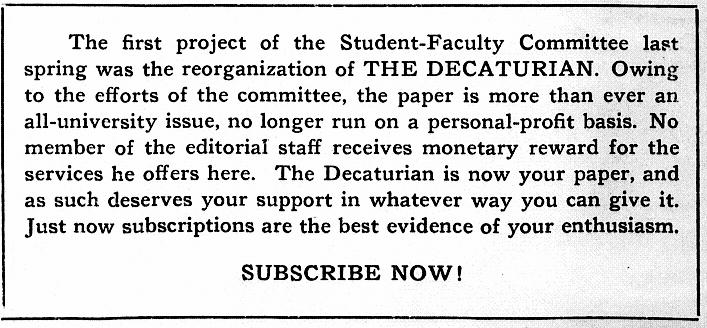
The Decaturian August 22, 1932 page 2 notice
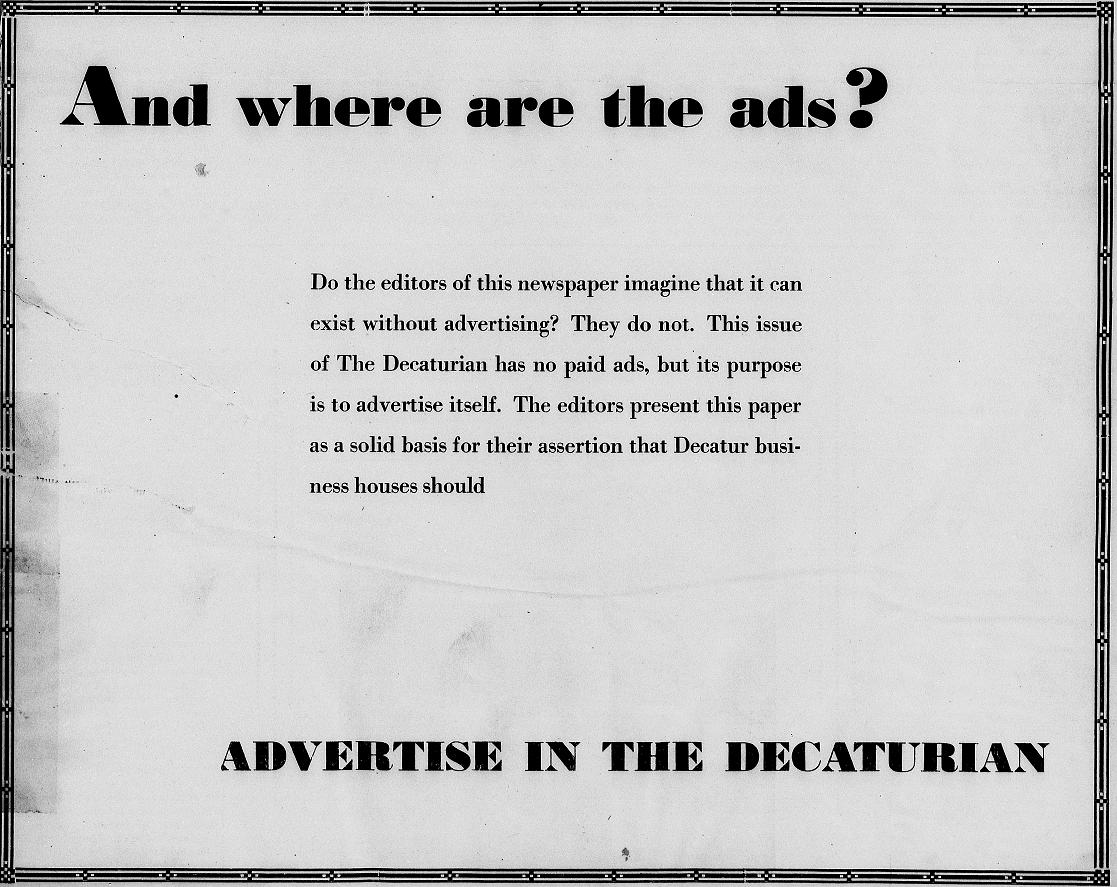
The Decaturian August 22, 1932 page 5
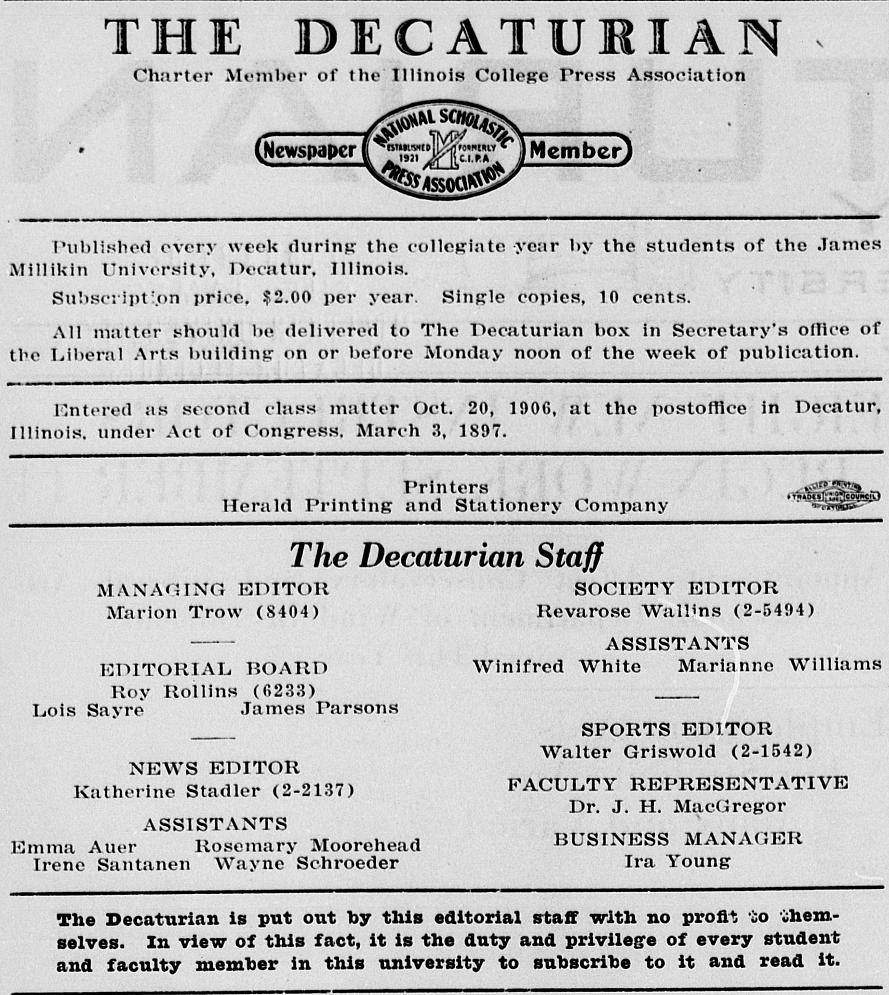
The Decaturian August 22, 1932 page 2 masthead
One of the new aspects of the Decaturian in 1932 was the advent of an Editorial Board which consisted of three members, one of which was James Parsons who would graduate from Millikin in 1934, and later from the University of Chicago Law school. In 1961, he was nominated by President John F. Kennedy to be a US District Court justice, becoming the first African-American to become a Federal Judge with life tenure.
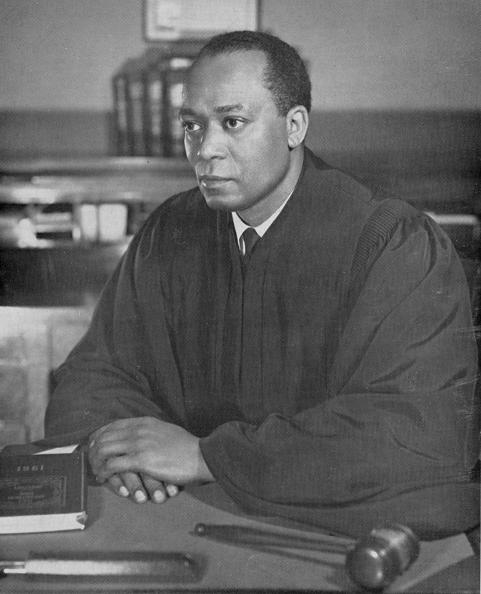
Judge James Parsons in 1961
So the Decaturian was restored to Millikin, and has remained a constant during the school year ever since. Though there was one more aspect of that special August 1932 issue that made it even more unique.

The Decaturian August 22, 1932 page 5
This simple section of the sports page of that issue is unique. In the upper left is an image of George Corbett, who had just joined the Chicago Bears after a great student athletic career at Millikin. In the lower left is a picture of Leo Johnson, then head football coach of Millikin, but also a Millikin alum and former Millikin football star who, along with six other of his Millikin teammates became members of the Decatur Staleys in 1920. That George Halas led squad would move to Chicago the next year and change its name to the Chicago Bears. In the bottom center is a picture of George Musso, who would captain that 1932 Millikin football team, and then follow Corbett's lead and join the Chicago Bears a year later. In 1982 he was elected to the NFL Hall of Fame in recognition of his great career with the Bears. So that page 5, made that unique August edition, a very "Beary" one as well. Click on the button below to read see that August issue.
MOUTHPIECE MAKES MERRY MAYHEM?
Did Millikin once sue the Wabash Railroad for half-a-million dollars due to "noisy train whistles?" Was there once a "Commie Riot" raided by the FBI in Albert Taylor Hall? Well, if you read the Decaturian issues that come out around April 1st and you might think so. When the March 29, 1928 issue of the Decaturian was published, a new Dec tradition was born with it, that of the April Fool's edition. Click on the button below to read that issue.
The issue was printed in red ink and had "April Fool's Number" clearly written across the top to identify the stories therein as being pranks but as the tradition continued off and on over the years, the labeling wasn't quite as clear.
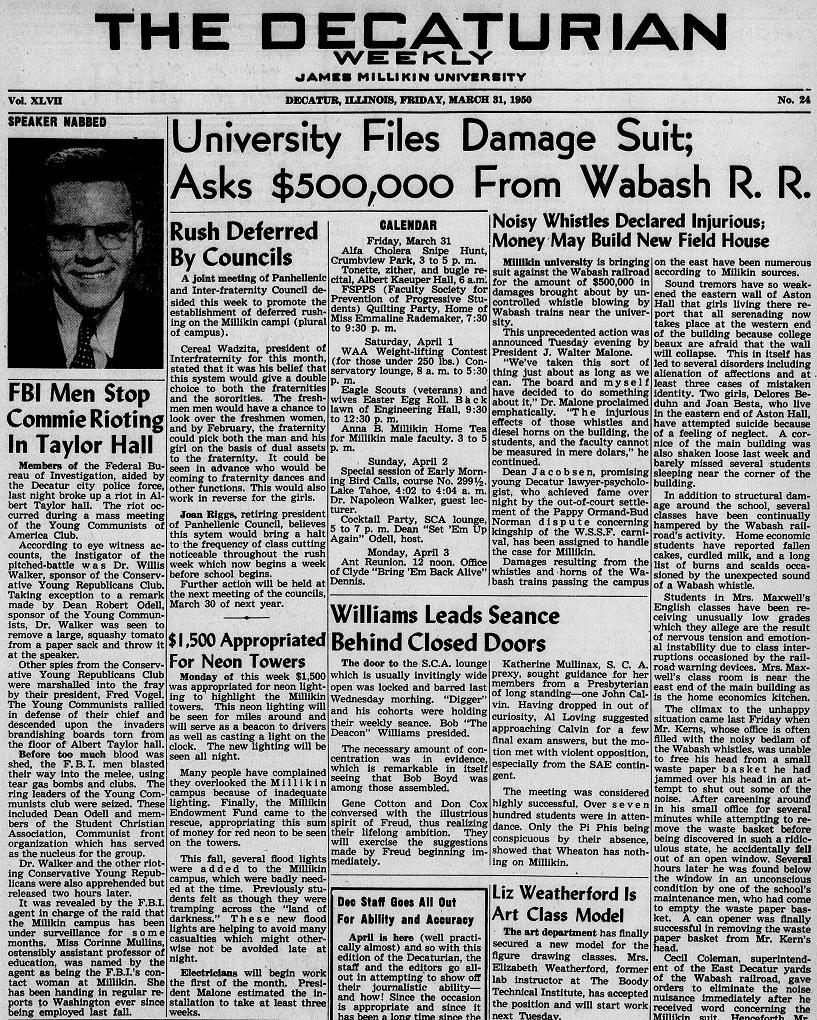
The Decaturian March 31, 1950 frontpage
The example above from 1950 makes no indication that these front page stories are fictional prank stories for April Fool's. In fact, the Commie riot joke was even set up in the previous edition which contained a notice about a Young Communists of America group meeting the following week [see the "Calling All Commies" notice in second column of front page of the March 24, 1950 issue by clicking the button below].
At times the Decaturian has been given a new name for the April Fool's occassion of the issue, such as "The Depravaturian.”
MILITARY MILLIKIN MOUTHPIECE?
During World War II, Millikin University temporarily became home to an U.S. Army unit, the 78th College Training Detachment, or 78th CTD. The unit was designed to provide training to Army Air Corps cadets such as initial flight training (which took place at the Decatur airport). Over 1000 Air Corps cadets would be trained throughout the duration of the program at Millikin University. Its arrival in early spring of 1943 filled the pages of those issues of the Decaturian, but when the University proper began its fall of 1943 semester, the cadets were given there own section of the paper. As cadets would graduate and new ones would arrive, there comings and goings and happenings on and around campus were recorded in the Decaturian.

The Decaturian September 24, 1943 page 4 column heading
This heading was used to identify the Cadet portion of the Dec
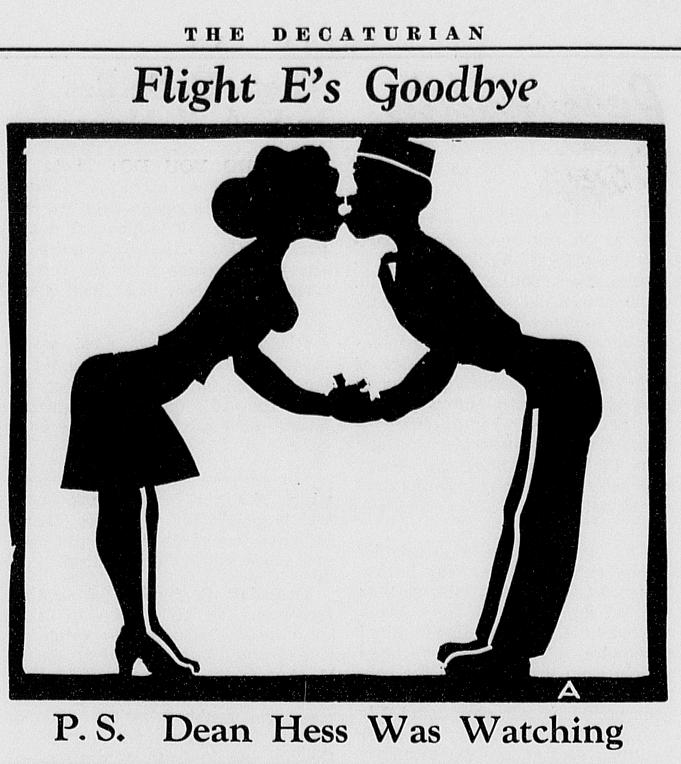
The Decaturian October 1, 1943 page 4 cartoon
This reveals two of the biggest subjects of the Cadets columns, humor and, of course, romance.
Apart from the contributions of 78th CTD cadets, World War II-era Decaturians also contained letters from those former Millikinites serving all over the globe. In fact, the Decaturian itself was sent out all over the globe to provide a bit of morale and news from "back home" to former Millikinites serving their country.

The Decaturian April 22, 1943 page 3 advertisement
This ad announced that the Millikin Student Council was going to underwrite the cost of sending the Decaturian to service men who wished it and to make sure cadets training at Millikin also received free copies without paying for a subscription.
The war brought other changes to the Decaturian as well, including a subtle one atop the "Dust Pan" gossip column. Started in the late 1930s, the "Dust Pan" had been a gossip column that featured a graphic drawing of "Mr. Squeegy" crawling along searching out gossip as can be seen below.

The Decaturian May 8, 1942, page 2 graphic
When the October 1, 1943 issue appeared. Mr. Squeegy was replaced by Mrs. Squeegy with the announcement that Mr. Squeegy had gone to serve his country and was being replaced at his civilian job by his wife.
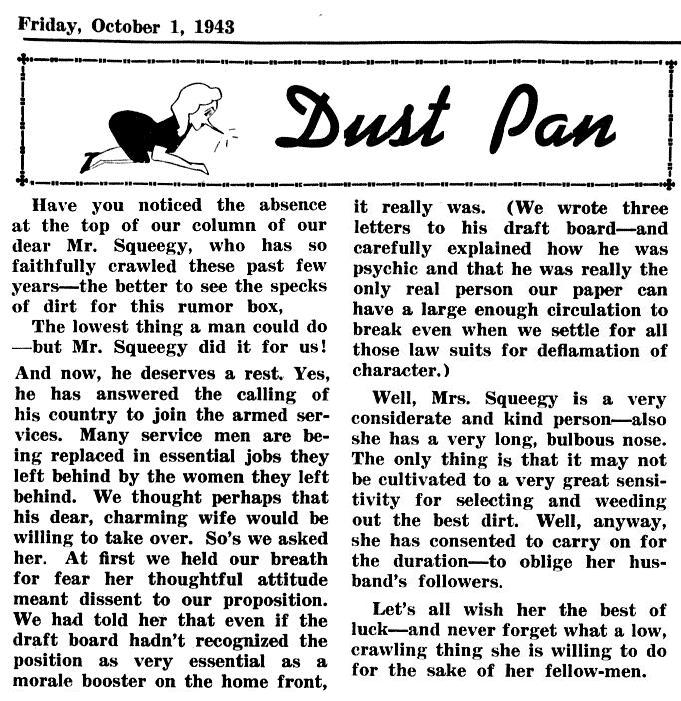
All was not light and jest during the war for The Decaturian.

The Decaturian April 27, 1945 page 1
This April 27, 1945 death notice for Wayne Wilson reveals the most direct and tragic impact the war had on both the Decaturian and Millikin University as a whole, the loss of so many young lives. Wilson was just one of 33 Millikin men who lost their lives during World War II.
To learn more about Millikin during World War II, see the Archives exhibit on that subject here, Millikin During World War II.
DIGITAL DECATURIAN PROJECT
In the fall of 2007, Millikin University Archives applied for and was awarded an LSTA grant funded by the Illinois State Library (ISL), a Division of the Office of Secretary of State, using funds provided by the Institute of Museum and Library Services (IMLS), under the federal Library Services and Technology Act (LSTA).
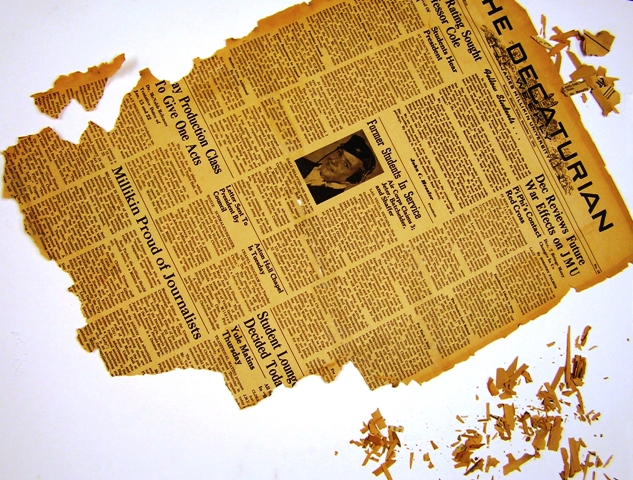
This image of the front page of the December 12, 1941 Decaturian as it was displayed for this exhibit reveals how rapidly many of The Decaturian issues were deteriorating and how much was being lost each time they were being handled.
The Archives had repeatedly pursued grant funding to begin a Digitization project for the Decaturian, as many of its issues were rapidly deteriorating [as can be seen in the sample page pictured above] and since there was no index to them, they had to be handled in excess to scan pages for pertinent information valuable to various research requests. The grant funds allowed for the extant copies of the Decaturian, from the first issue of the 1903 to the final issue of the spring of 1951, to be sent to OCLC Preservation Services in Pennsylvania for imaging, digitization, and processing for digital presentation using the CARLI Digital Collections web site powered by CONTENTdm. The results of the project provided the Archives with both microfilm preservation copies of the Decaturian and hi-resolution TIFF images of each page processed. In addition, the images and metadata that now make those first 40+ years of the Decaturian full-text searchable and available online were created and uploaded on the CARLI Digital Collections server.
It is hoped in the future that funding will become available to complete the project, digitizing and processing the issues from 1951 to the present. This exhibit would not have been possible without the grant funding of the project.
The link takes you to the collection homepage for the Decaturian while the many that appear within the exhibit above will take you to specific pages within specific issues. By going to the homepage, you can use the site's search tools to search the issues for your own research or just browse issues online.
Exhibit Created: September 28, 2009 by Todd Rudat
Last Modified: October 5, 2009 by Todd Rudat


















